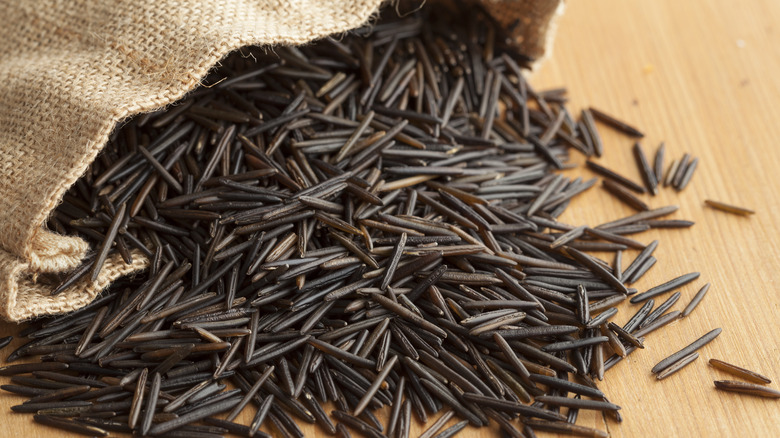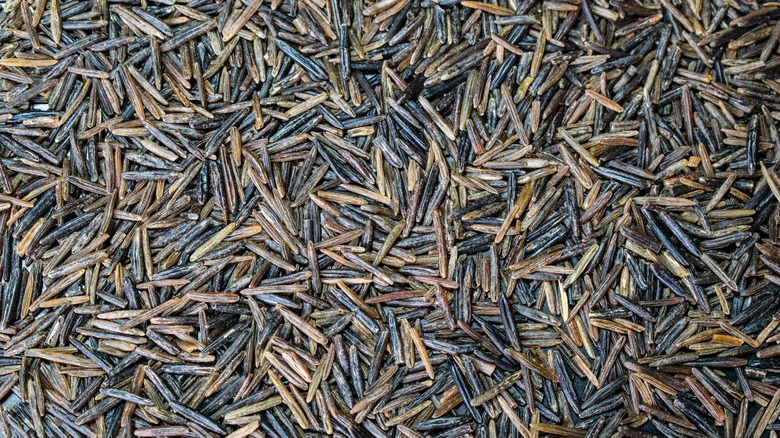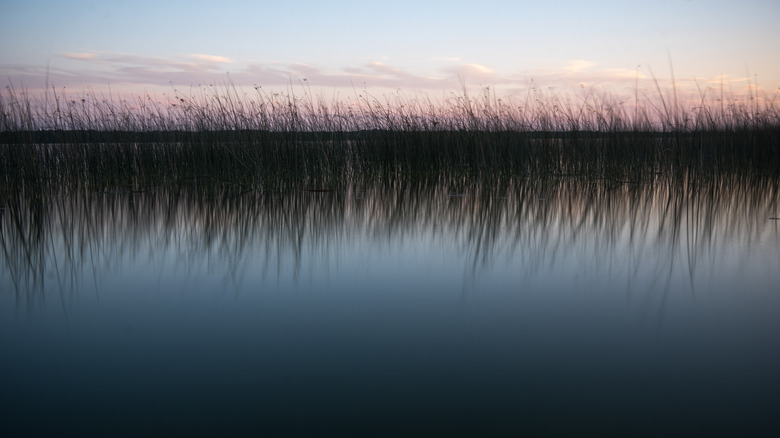It Turns Out Most 'Wild Rice' We Buy Isn't Actually That Wild At All
One of the oral histories from the Anishinaabeg people says that a prophet told them to head west until they found the land where food grew on water. In roughly A.D. 900, they settled in Minnesota, where wild rice grew in the shallow lakes, streams, and marshes. They called it "manoomin," meaning "good grain," and it has been one of their most important foods ever since.
They'd paddle or pole their canoes out onto the water in pairs, one person driving the canoe forward and the other bending the grass over the boat, gently knocking the grain into it. They'd come back to shore with canoes so full, they'd barely be able to get back out of them. The grains that would fall into the water would propagate the next season's wild crop, the closest the Anishinaabeg got to "planting" this crop.
Some of the wild rice on the market today is still truly wild, but you have to either visit the northern Midwest or special-order it. Over 95% of the wild rice on store shelves is cultivated, or "paddy" rice, domesticated by the University of Minnesota in the 1950s and highly cultivated in California since the 1970s. It's a planted, hybridized crop bred to all ripen at the same time for easy and efficient machine harvests by draining artificially flooded dikes. It's similar to but not quite the same as truly wild rice, and there are easy ways to tell the difference if you know what to look for.
The difference between wild-grown and cultivated wild rice
For the sake of lessening confusion, we're going to refer to truly wild-grown wild rice as "wild rice" and refer to cultivated, paddy-grown wild rice as "paddy rice." The easiest way to tell is that Minnesota and Wisconsin require paddy rice to be labeled as such, and any California-grown rice is always paddy rice.
Wild rice goes through a process called hand parching. It is dried over a fire in metal drums in batches, attended to by someone continually moving it with a large spatula. When the harvest is very plentiful and the whole boatload of rice can't be parched in a single day, it is laid out in the shade to dry, but it's not intentionally cured. Between this process and the nuances of the waterways it's grown in, finished wild rice is a lighter brown color and has a nutty, almost smokey taste.
Paddy rice, on the other hand, is steamed and fermented for up to six days before being dried in a heated drum, simulating hand parching. This creates a tougher grain, good for shipping to grocery stores or food processors making cans of chicken-and-wild-rice soup, for example. The grains of paddy rice are a deep, glossy black from the fermentation process. They're chewier than wild rice, too, and have a much milder flavor. When it comes down to it, though, almost all your wild rice is paddy grown.
The benefits and disadvantages of wild and paddy rice
Both wild and paddy rice are threatened by climate change. In 2022, Minnesota and Wisconsin faced seriously dry conditions that strained wild rice crops and made harvesting much more difficult. In 2023, Minnesota especially is facing massive flooding that will likely wipe out much of the year's crops. And there's not as much of it as there once was. Wild rice territory has shrunken dramatically since Minnesota was colonized, largely due to agriculture and the diversion of water. The waterways that wild rice grows in need some water flow for the rice to be healthy, but previously healthy habitats have, over time, dried up due to the diversion of the area's hydrology for farmers' fields of row crops.
Paddy rice is also susceptible to these woes, but it is bred to be more resilient. And because it is a planted crop rather than a wild one, the USDA offers crop insurance to paddy rice farmers; they are covered if their yield falls below their production guarantee. Wild rice harvesters don't have the same benefit. The USDA announced a purchase program for traditionally harvested wild rice in early 2016 in an effort to support wild rice harvesters — many of whom are indigenous.
Most of us will never have truly wild rice unless we intentionally seek it out. If you're interested in getting some for a comparison tasting, it can be purchased online from places like Native Harvest and Moose Lake Wild Rice.


